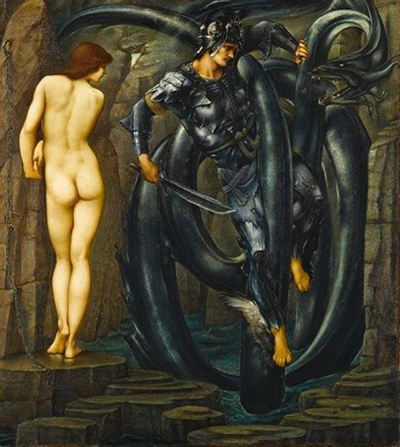The Doom Fulfilled was painted by Edward Bourne-Jones between 1884 and 1885, and it was part of the Perseus series. The painting was commissioned for Arthur Balfour, a British statesman and arts patron. Like other works in this series, the painting draws upon the Perseus legend as told by William Morris in The Doom of King Acrisius.
The Doom Fulfilled details a later part of the story of Perseus. Those who know the story will recall that Perseus rescued his lover from Kraken, a sea monster. In this painting, the two lovers seem to be in a cave, and the sea is not depicted. Still, Perseus tries to battle the sea monster, which is seen to be covered in metal armour or sea scales. His eyes are locked with those of Kraken, and his lover stands nude on the side. The artist employed the romanticism style in this painting. This style was quite popular in the 19th century. It challenged the rational ideal which was strongly held in the Enlightenment Age. The art form tried to show that emotion and sense were very important in understanding and experiencing the world.
The Doom Fulfilled is classified as a mythological painting as it is based on a Greek myth. It tells a story of the heroic triumph of good over evil. Perseus is the son of the God Zeus, and that puts him on the right side. It is worth noting that most mythological paintings of the era were based on Greek or Roman myths. This is primarily because the Italian Renaissance venerated art forms of classical antiquity. The biggest critics of the Enlightenment Age also had a strong interest in Roman and Greek mythologies.
The Doom Fulfilled was painted using the oil on canvas method. This painting method first grew in popularity in Europe in the 15th century. It presented major advantages over alternative painting methods. One of the biggest advantages of oil on canvas paintings was that the paint dried slowly and gave the artists time to make quick changes. The paintings also lasted for lengthy periods.




